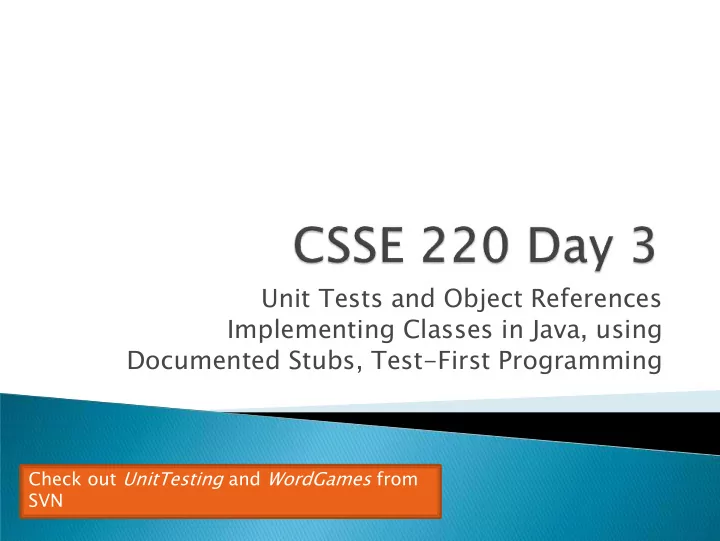

Unit Tests and Object References Implementing Classes in Java, using Documented Stubs, Test-First Programming Check out UnitTesting and WordGames from SVN
Don’t try to memorize the Java libraries ◦ Nearly 9000 classes and packages! ◦ You’ll learn them over time Get in the habit of writing the javadocs bef efore re implementing the methods ◦ It will help you think before doing, a vital software development skill ◦ This is called programming with documente umented d stubs bs ◦ I’ll try to model this. If I don’t, call me on it! Q1
Test-driven Development, unit testing and JUnit
Using code that you write to test other code ◦ Focused on testing individual pieces of code (units) in isolation Individual methods Individual classes Why would software engineers do unit testing? Q2
JUnit is a unit testing framework ◦ A framework is a collection of classes to be used in another program. ◦ Does much of the work for us! JUnit was written by ◦ Erich Gamma ◦ Kent Beck Open-source software Now used by millions of Java developers Q3
MoveTester in Big Java shows how to write tests in plain Java Look at JUnitMoveTester in today’s repository ◦ Shows the same test in JUnit ◦ Let’s look at the comments and code together…
Important Slide: Use this as a reference! Test ―boundary conditions‖ ◦ Intersection points: - 40℃ == - 40℉ ◦ Zero values: 0℃ == 32℉ ◦ Empty strings Test known values: 100℃ == 212℉ ◦ But not too many Tests things that might go wrong ◦ Unexpected user input: ―zero‖ when 0 is expected Vary things that are ―important‖ to the code ◦ String length if method depends on it ◦ String case if method manipulates that
Unit test shout , whisper , and holleWerld using ―interesting‖ test cases
Differences between primitive types and object types in Java
Variables of number type store values Variables of class type store references ◦ A reference is like a pointer in C, except 10 Java keeps us from screwing up 20 box No & and * to worry about (and the people say, ―Amen‖) 5 Consider: x 10 5 1. int x = 10; y 20 2. int y = 20; 3. Rectangle box = new Rectangle(x, y, 5, 5); Q4
Actual value for number types Re Refer erence ence value for object types ◦ The actual object ct is not copied ied × 9 5 ◦ The refere erence nce va value ue (―the pointer‖) is copi pied × 10 6 Consider: box x 1. int x = 10; 10 7 2. int y = x; box2 8 × 20 y 3. y = 20; 10 4. Rectangle box = new Rectangle(5, 6, 7, 8); 5. Rectangle box2 = box; 6. box2.translate(4, 4); Q5 – Q6
Separating implementation details from how an object is used
Encapsulation — separating implementation details from how an object is used ◦ Client code sees a black box with a known interface ◦ Implementation can change without changing client Functi tions ons Objects ts Black box Function Constructor and expose ses signature method signatures Encapsul sulated ated Operation Data storage ge and inside e the e box implementation oper erat ation on implementa ementatio tion Q7 – Q8
But surely I owe you an accurate answer!
Create ate the (initially empty) class ss 1. 1. File ⇒ New ⇒ Class ◦ Write docu cumented ented stubs bs for the public interface of the class 2. Implem lemen ent the class ss: 3. 3. Determine and implement instance fields ◦ Implement constructors and methods, adding private methods and ◦ additional instance fields as needed Test t the e clas ass 4. 4. 3. Test and implement each constructor and method Write the test cases BEFORE • implementing the constructor/method
WordGames Shouter
Censor nsor: given a string inputString putString , produces a new string by replacing each occurrence of charTo arToCensor Censor with a ― * ‖ (an asterisk). How do you deal with char arToCen ToCensor sor ? ◦ Can it be a parameter of transform ? No, that violates the StringTransformable interface ◦ Can it be a local variable of transform ? No, it needs to live for the entire lifetime of the Censor. ◦ What’s left? Answer: It is a field ! (What is a sensible name for the field?) How do you initialize the field for char harToCens ToCensor or ? ◦ Answer: by using Censor’s constructors!
WordGames Censor
Continue with homework if time permits Q9 – Q10
Recommend
More recommend